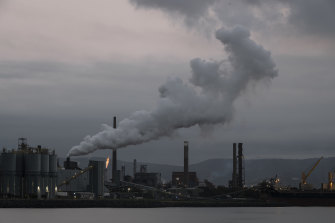The world’s biggest governments are still propping up fossil fuels
By Nathaniel Bullard – Jul 23, 2021
The International Energy Agency published a hopeful finding last month on global subsidies for fossil fuel consumption, showing a fall of more than 40 per cent in 2020 — following a drop of more than 30 per cent in 2019.
That does not, however, mean that countries have reduced their support for fossil fuel industries.
Two things helped lower these subsidies: a sharp drop in consumption during the pandemic, and a significant drop in prices. The full breadth of government support, however, covers a lot more than lowering the price tags consumers see. It also includes investment by state-owned companies, budgetary transfers, tax breaks, and concessional grants and loans from public financial institutions.

In a new report to the Net Zero Asset Owner Alliance, my colleagues at BloombergNEF have added up fossil fuel support from the G20 governments. Their work shows that support to state-owned energy companies — often their countries’ sole energy supplier — constitutes 45 per cent of total fossil fuel subsidies, while consumer subsidies are a little over 21 per cent.
Those amounts don’t track particularly well to the underlying cost of energy. Over that same five years, the spot price of Brent crude swung from less than $US30 a barrel to nearly $US90. This lack of alignment indicates that the connection between near-term energy prices and long-term support for energy is loose at best.
That’s not to say there’s been no progress at all in reducing support for fossil fuels in the G20. Saudi Arabia, for instance, has cut its total support for fossil fuels by half since 2015 — but still provides nearly three times as much per capita as any other government.
Fully half of those governments have supported fossil fuels less since 2015 — but then again, the law of averages means that at least some of the remaining half have raised theirs. Both Canada and the US raised their subsidies significantly on a percentage basis, but Canada provides almost 10 times the per capita support to its industry as the US, almost all of which is public finance for oil and gas producers and utilities. Argentina, meanwhile, is the second-highest supporter per capita, even despite declining consumer subsidies, with state-owned companies receiving more than 80 per cent of support.
Government backing for consumer energy prices is important. Artificially low electricity prices provide little incentive for conserving electricity. Artificially low road fuel costs give little incentive for vehicle-owners to switch from internal combustion engines to electric models.
Support at the business level, however, could be even more significant for the long-term prospects of decarbonization. Government funding capacity may not be strictly limited, but it’s also not infinite, and funds devoted to supporting an incumbent fossil fuel industry are by definition not able to fund energy transition.
Just as importantly, government support has the potential to lock in assets — and the behaviours that go with them — for decades. Those include assets and behaviours related not just to the consumption of fossil fuels, but also to the production and distribution of same, not to mention the politics that go along with them. Government action also creates future unfunded liabilities in the form of potential bills for clean-up and environmental mediation.
Finally, governments may be creating future stranded assets, projects that for either policy or economic reasons could soon be permanently out of the money.
If we want to achieve a net-zero energy system by mid-century, companies and governments will need to invest anywhere from $US92 trillion to $US173 trillion in the next three decades, according to BNEF’s latest New Energy Outlook. Doing so will be difficult, but not impossible. Every dollar supporting any path other than zero net carbon dioxide emissions by 2050, however, makes net zero all the more difficult in the meantime.


